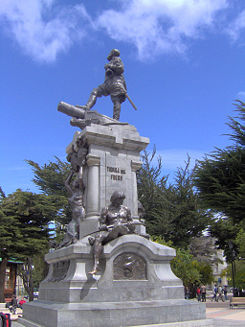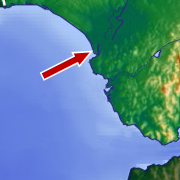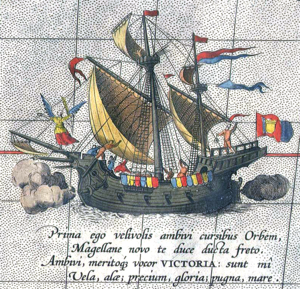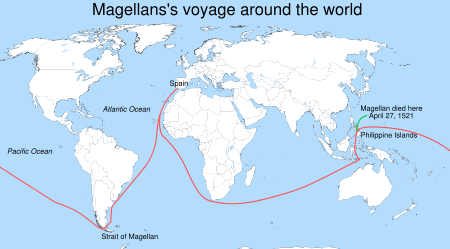Ferdinand Magellan
2008/9 Schools Wikipedia Selection. Related subjects: Geographers and explorers
| Ferdinand Magellan | |
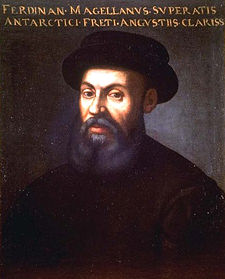 Portuguese maritime explorer
|
|
| Born | Spring 1480 Sabrosa, Portugal |
|---|---|
| Died | April 27, 1521 Cebu, Philippines |
| Other names | pt: Fernão de Magalhães es: (F/H)ernando de Magallanes |
| Known for | Captained the first circumnavigational expedition; located the Magellanic Straits. |
Ferdinand Magellan (Portuguese: Fernão de Magalhães, IPA: [fɨɾˈnɐ̃ũ dɨ mɐgɐˈʎɐ̃ĩʃ] Spanish: Fernán de Magallanes) (Spring 1480 – April 27, 1521, Mactan Island, Cebu, Philippines) was a Portuguese maritime explorer who, while in the service of the Spanish Crown, tried to find a westward route to the Spice Islands of Indonesia. This was the first successful attempt to circumnavigate the Earth in history. Although he did not complete the entire voyage (he was killed during the Battle of Mactan in the Philippines) fellow Basque-navigator Juan Sebastian Elcano completed the final westward voyage. As Magellan traveled farther west than the Spice Islands, which he had visited on earlier voyages from the west, he became one of the first individuals to cross all the meridians of the globe. He was the first person to lead an expedition sailing westward from Europe to Asia and to cross the Pacific Ocean.
Magellan was the first European to enter the Pacific from the eponymous Strait of Magellan, which he discovered. He was also the first European to reach the archipelago of what is now known as the Philippines, which was unknown to the western world before his landing. Arab traders had established commerce within the archipelago centuries earlier.
Of the 237 men who set out on five ships to circumnavigate the earth, only 18 completed the circumnavigation of the globe and managed to return to Spain in 1522. They were led by a Basque Juan Sebastián Elcano, who took over command of the expedition after Magellan's death. Seventeen other men arrived later in Spain, twelve men captured by the Portuguese in Cape Verde some weeks later, and in 1525/1526 five survivors of the Trinidad.
Origins and first voyage
Magellan, because of his family's royal heritage, became a page to Queen Leonor at the royal court after the death of his parents during his tenth year. Very little is known about Magellan's background. He was the son of Rui de Magalhães (son of Pedro Afonso de Magalhães and wife Quinta de Sousa) and wife Alda de Mesquita, and brother of Duarte de Sousa, Diogo de Sousa and Isabel de Magalhães, but exactly how he is connected to the respective families it is unknown. He was married to Beatriz Barbosa and had two children: Rodrigo de Magalhães and Carlos de Magalhães, both of whom died at a young age.
Magellan made his first known expedition at sea at the age of 25 in 1505, when he was sent to India to install Francisco de Almeida as the Portuguese viceroy. The voyage gave Magellan his first experience of battle when a local king, who had paid tribute to Vasco da Gama three years earlier, refused to pay tribute to Almeida, which resulted in the Battle of Diu in 1509. After taking leave without permission, Magellan fell out of favour with Almeida and was also accused of trading illegally with the Moors. Several of the accusations were subsequently proved and there were no further offers of employment after May 15, 1514. Later on in 1515, Magellan had an employment offer as a crew member on a Portuguese ship, but rejected this offer.
Spanish search of the Spice Islands
The aim of Christopher Columbus' voyage to the West was to reach the coasts of the Spice Islands (or the Indies) and to establish commercial relations between Spain and the several Asian kingdoms. The Spanish soon realised after Columbus' voyages that the lands of the Americas were not a part of Asia, but a new continent. Once Vasco da Gama and the Portuguese arrived in India in 1498, it became urgent for Spain to find a new commercial route to Asia. The Treaty of Tordesillas reserved for Portugal the routes that went around Africa. The Spanish Crown then decided to send out exploration voyages in order to find a way to Asia by travelling westwards. Vasco Núñez de Balboa sailed the Pacific Ocean in 1513, and Juan Díaz de Solís died in Río de la Plata some years later trying to find a passage in South America.
When Magellan arrived at the Court of Spain, he presented King Charles V with a plan that would give the ships of the Crown of Castile full access to the lands of the Spice Islands, after that plan failing to gain approval from the Portuguese king, Manuel I.
Journey
On August 10, 1519, five ships under Magellan's command – Trinidad, San Antonio, Concepción, Victoria, and Santiago – left Seville and travelled from the Guadalquivir River to Sanlúcar de Barrameda at the mouth of the river, where they remained more than five weeks.
Spanish authorities were wary of Magellan, who was originally Portuguese. They almost prevented the admiral from sailing, and switched his crew from mostly Portuguese men to men of Spain. Nevertheless, Magellan set sail from Sanlúcar de Barrameda with about 270 men on September 20. King Manuel ordered a Portuguese naval detachment to pursue Magellan, but Magellan avoided them. After stopping at the Canary Islands, Magellan arrived at Cape Verde, where he set course for Cape St. Augustine in Brazil. On November 27, the expedition crossed the equator; on December 6, the crew sighted South America.
Since Brazil was Portuguese territory, Magellan avoided it, and on December 13 anchored near present-day Rio de Janeiro. There the crew was resupplied, but bad conditions caused them to delay. Afterwards, they continued to sail south along South America's east coast, looking for the strait that Magellan believed would lead to the Spice Islands. The fleet reached Río de la Plata on January 10, 1520.
On March 30, the crew established a settlement they called Puerto San Julian. On April 2, a mutiny involving two of the five ship captains broke out, but it was unsuccessful because the crew remained loyal. Juan Sebastián Elcano was one of those who were forgiven. Antonio Pigafetta, an Italian from Vicenza who paid to be on the Magellan voyage, related that Gaspar Quesada, the captain of Concepcion, was executed; Juan de Cartagena, the captain of San Antonio, and a priest named Padre Sanchez de la Reina were instead marooned on the coast. Another account states that Luis de Mendoza, the captain of Victoria, was executed along with Quesada. Reportedly those killed were drawn and quartered and impaled on the coast; years later, their bones were found by Sir Francis Drake.
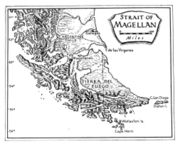
The journey resumed. The Santiago was sent down the coast on a scouting expedition and was wrecked in a sudden storm. All of its crew survived and made it safely to shore. Two of them returned overland to inform Magellan of what had happened, and to bring rescue to their comrades. After this experience, Magellan decided to wait for a few weeks more before again resuming the voyage.
At 52°S latitude on October 21, the fleet reached Cape Virgenes and concluded they had found the passage, because the waters were brine and deep inland. Four ships began an arduous trip through the 373-mile (600 km) long passage that Magellan called the Estrecho (Canal) de Todos los Santos, ("All Saints' Channel"), because the fleet travelled through it on November 1, or All Saints' Day. The strait is now named the Strait of Magellan. Magellan first assigned Concepcion and San Antonio to explore the strait, but the latter, commanded by Gomez, deserted and returned to Spain on November 20. On November 28, the three remaining ships entered the South Pacific. Magellan named the waters the Mar Pacifico (Pacific Ocean) because of its apparent stillness. Magellan was the first European to reach Tierra del Fuego just east of the Pacific side of the strait.
Death
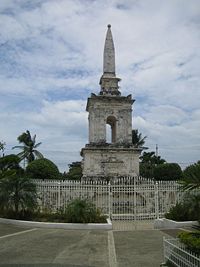
Heading northwest, the crew reached the equator on February 13, 1521. On March 6, they reached the Marianas and Guam. Magellan called Guam the "Island of Sails" because they saw a lot of sailboats. They renamed it to "Ladrones Island" (Island of Thieves) because many of Trinidad's small boats were stolen there. On March 16, Magellan reached the island of Homonhon in the Philippines, with 150 crew left, and became the first European to reach the Philippines.
Magellan was able to communicate with the native peoples because his Malay interpreter, Enrique, could understand their language. Enrique was indentured by Magellan in 1511 right after the sacking of Malacca, and was at his side during the battles in Africa, during Magellan's disgrace at the King's court in Portugal, and during Magellan's successful raising of a fleet. They traded gifts with Rajah Siaiu of Mazaua who guided them to Cebu on April 7.
Rajah Humabon of Cebu was friendly towards Magellan. Rajah Humabon and his queen Juana even accepted Christianity. Afterward, Humabon and his rival Datu Zula convinced Magellan to kill their enemy, Lapu-Lapu, on Mactan. Magellan had wished to convert Lapu-Lapu to Christianity, as he had Rajah Humabon, a proposal to which Lapu-Lapu was dismissive. On the morning of April 17, 1521, Magellan sailed to Mactan with an army of men. During the resulting Battle of Mactan against indigenous forces led by Lapu-Lapu, Magellan was killed.
Pigafetta and Ginés de Mafra provided the only extant eyewitness accounts of the events culminating in Magellan's death:
| “ | When morning came, forty-nine of us leaped into the water up to our thighs, and walked through water for more than two cross-bow flights before we could reach the shore. The boats could not approach nearer because of certain rocks in the water. The other eleven men remained behind to guard the boats. When we reached land, [the natives] had formed in three divisions to the number of more than one thousand five hundred people. When they saw us, they charged down upon us with exceeding loud cries... The musketeers and crossbow-men shot from a distance for about a half-hour, but uselessly... Recognizing the captain, so many turned upon him that they knocked his helmet off his head twice... A native hurled a bamboo spear into the captain's face, but the latter immediately killed him with his lance, which he left in the native's body. Then, trying to lay hand on sword, he could draw it out but halfway, because he had been wounded in the arm with a bamboo spear. When the natives saw that, they all hurled themselves upon him. One of them wounded him on the left leg with a large cutlass, which resembles a scimitar, only being larger. That caused the captain to fall face downward, when immediately they rushed upon him with iron and bamboo spears and with their cutlasses, until they killed our mirror, our light, our comfort, and our true guide. When they wounded him, he turned back many times to see whether we were all in the boats. Thereupon, beholding him dead, we, wounded, retreated, as best we could, to the boats, which were already pulling off. | ” |
Magellan provided in his will that Enrique, his interpreter, was to be freed upon his death. However, after Mactan, the remaining ships' masters refused to free Enrique. Enrique escaped his indenture on May 1, with the aid of Rajah Humabon, amid the deaths of almost 30 crewmen. Pigafetta had been jotting down words the Bisayan language, both Butuanon and Cebuano--which he started at Mazaua on Friday, March 29 and grew to a total of 145 words--and was apparently able to continue communications during the rest of the voyage. The Spaniards offered the natives with merchandises in exchange for Magellan's body, but they were declined and his body was never recovered.
Circumnavigation and return
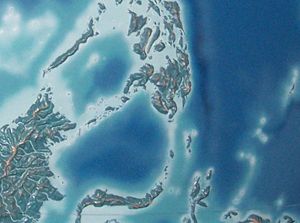
The casualties suffered in the Philippines left the expedition with too few men to sail the three remaining ships. Consequently, on May 2, they abandoned Concepción and burned the ship. The fleet, reduced to Trinidad and Victoria, fled westward to Palawan. They left that island on June 21, and were guided to Brunei, Borneo by Moro pilots who could navigate the shallow seas. They anchored off the Brunei breakwater for 35 days, where Pigafetta, an Italian from Vicenza, recorded the splendour of Rajah Siripada's court (gold, two pearls the size of hens' eggs, etc.). In addition, Brunei boasted tame elephants and armament of 62 cannons, more than 5 times the armament of Magellan's ships, and Brunei disdained cloves, which were to prove more valuable than gold, upon the return to Spain. Pigafetta mentions some of the technology of the court, such as porcelain and eyeglasses (both of which were not available or only just becoming available in Europe).
After reaching the Maluku Islands (the Spice Islands) on November 6, 115 crew were left. They managed to trade with the Sultan of Tidore, a rival of the Sultan of Ternate, who was the ally of the Portuguese.
The two remaining ships, laden with valuable spices, attempted to return to Spain by sailing west. However, as they left the Spice Islands, the Trinidad began to take on water. The crew tried to discover and repair the leak, but failed. They concluded that Trinidad would need to spend considerable time being overhauled, but the small Victoria was not large enough to accommodate all the surviving crew. As a result, Victoria with some of the crew sailed west for Spain. Several weeks later, Trinidad departed and attempted to return to Spain via the Pacific route. This attempt failed. Trinidad was captured by the Portuguese, and was eventually wrecked in a storm while at anchor under Portuguese control.
Victoria set sail via the Indian Ocean route home on December 21, commanded by Juan Sebastián Elcano. By May 6, the Victoria rounded the Cape of Good Hope, with only rice for rations. Twenty crewmen died of starvation before Elcano put into Cape Verde, a Portuguese holding, where he abandoned 13 more crew on July 9 in fear of losing his cargo of 26 tons of spices (cloves and cinnamon).
On September 6, 1522, Elcano and the remaining crew of Magellan's voyage arrived in Spain aboard the last ship in the fleet, Victoria, almost exactly three years after they departed. Magellan had not intended to circumnavigate the world, only to find a secure way through which the Spanish ships could navigate to the Spice Islands; it was Elcano who, after Magellan's death, decided to push westward, thereby completing the first voyage around the entire Earth.
Maximilianus Transylvanus interviewed the surviving members of the expedition when they presented themselves to the Spanish court at Valladolid in the autumn of 1522, and wrote the first account of the voyage, which was published in 1523. The account written by Pigafetta did not appear until 1525, and was not wholly published until 1800. This was the Italian transcription by Carlo Amoretti of what we now call the Ambrosiana codex. The expedition eked out a small profit, but the crew was not paid full wages.
Four crewmen of the original 55 on Trinidad finally returned to Spain in 1525; 51 of them had died in war or from disease. In total, approximately 232 Spanish, Portuguese, Italian, French, English and German sailors died on the expedition around the world with Magellan.
Legacy
Magellan's expedition was the first to circumnavigate the globe and the first to navigate the strait in South America connecting the Atlantic and Pacific oceans. Magellan's crew observed several animals that were entirely new to European science, including a "camel without humps", which could have been a llama, guanaco, vicuña, or alpaca. A black "goose" that had to be skinned instead of plucked was a penguin.
Two of the closest galaxies, the Magellanic Clouds, were discovered by crew members in the southern hemisphere. The full extent of the Earth was also realized, since their voyage was 14,460 leagues (69,800 km or 43,400 mi).
The need for an International Date Line was established. Upon returning they found their calendars were a day behind, even though they had faithfully maintained the ship's log. However, they did not have clocks accurate enough to observe the very slight lengthening of each day during which they were underway on the journey (and since they traveled west, after circumnavigation they had rotated about the earth's axis exactly one time less, hence experiencing one less night, than if they had remained in Spain). This caused great excitement at the time and a special delegation was sent to the Pope to explain the oddity to him.
The course that Magellan charted was followed by other navigators, all of whom met with failure until the voyage of Sir Francis Drake more than fifty years later, in 1577.
Survivors
When Victoria, the only surviving ship, returned to the harbour of departure after completing the first circumnavigation of the Earth. On board the small ship only 18 men out of the original 237 men were onboard.
| Name | Rating |
|---|---|
| Juan Sebastián Elcano, from Getaria | Master |
| Francisco Albo, from Rodas (in Tui, Galicia) | Pilot |
| Miguel de Rodas (in Tui, Galicia) | Pilot |
| Juan de Acurio, from Bermeo | Pilot |
| Antonio Lombardo (Pigafetta), from Vicenza | Supernumerary |
| Martín de Judicibus, from Genoa | Chief Steward |
| Hernándo de Bustamante, from Alcántara | Mariner |
| Nicholas the Greek, from Nafplion | Mariner |
| Miguel Sánchez, from Rodas (in Tui, Galicia) | Mariner |
| Antonio Hernández Colmenero, from Huelva | Mariner |
| Francisco Rodrigues, Portuguese from Seville | Mariner |
| Juan Rodríguez, from Huelva | Mariner |
| Diego Carmena, from Baiona (Galicia) | Mariner |
| Hans of Aachen, (Holy Roman Empire) | Gunner |
| Juan de Arratia, from Bilbao | Able Seaman |
| Vasco Gómez Gallego, from Baiona (Galicia) | Able Seaman |
| Juan de Santandrés, from Cueto ( Cantabria) | Apprentice Seaman |
| Juan de Zubileta, from Barakaldo | Page |
Martino de Judicibus
Among the survivors there were only two Italians, Antonio Pigafetta and Martino de Judicibus. Martino de Judicibus (Spanish: Martín de Judicibus) was a Genoese or Savonese Chief Steward. He served with Ferdinand Magellan on his historical voyage to find a westward route to the Spice Islands of Indonesia. His history is preserved in the nominative registers at the Archivo General de Indias in Seville, Spain. The family name is referred to with the exact Latin patronymic, "de Judicibus". He was initially assigned to the caravel Concepción, one of five ships of the small Spanish fleet of Magellan. Martino de Judicibus embarked on the expedition with the rank of merino.
